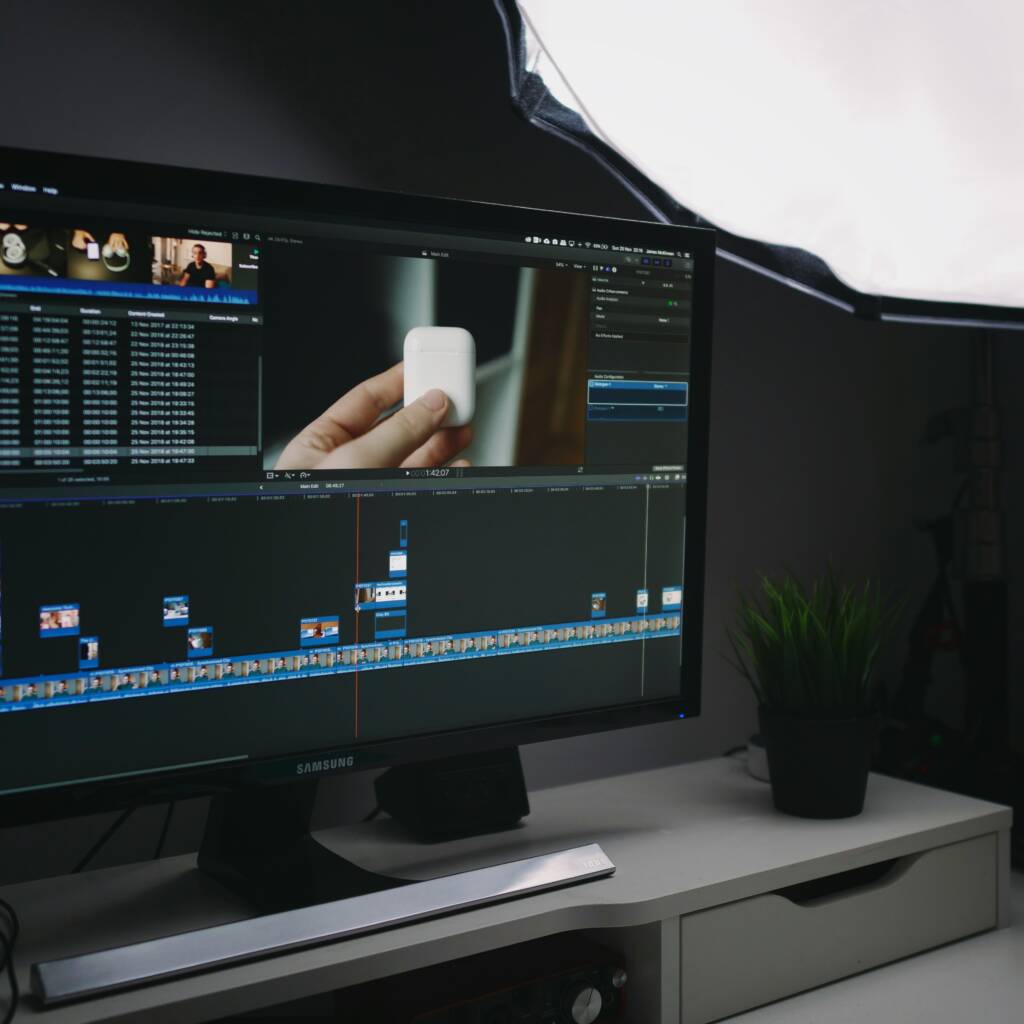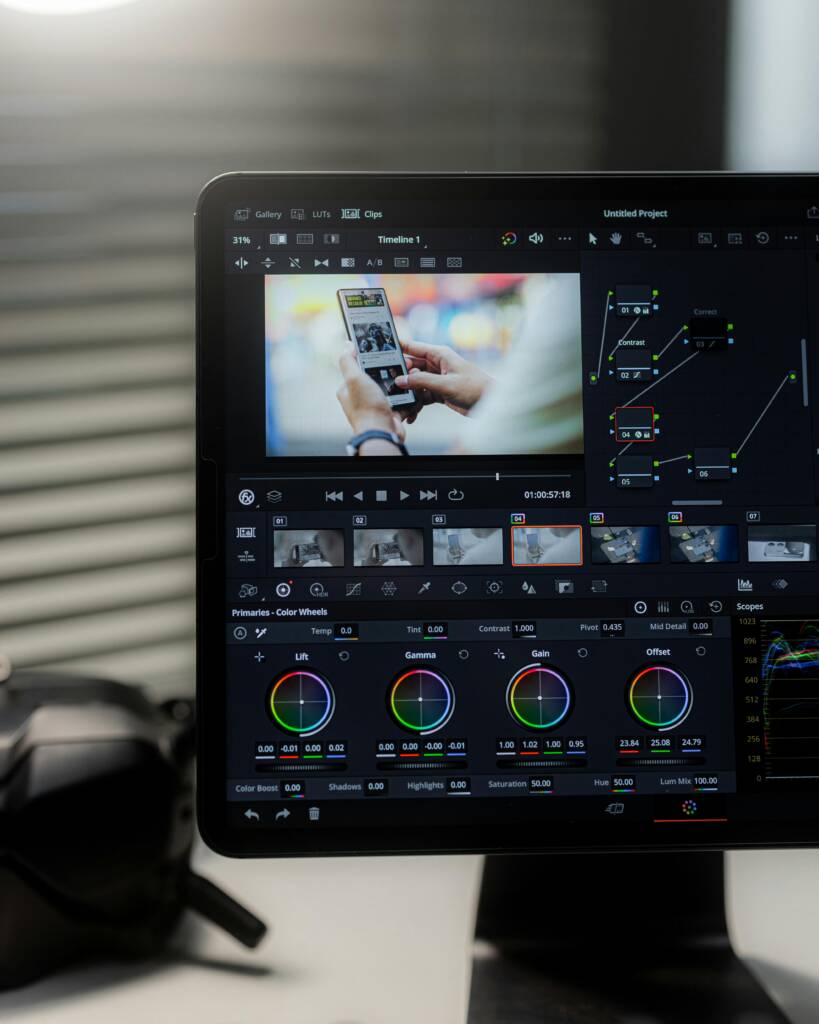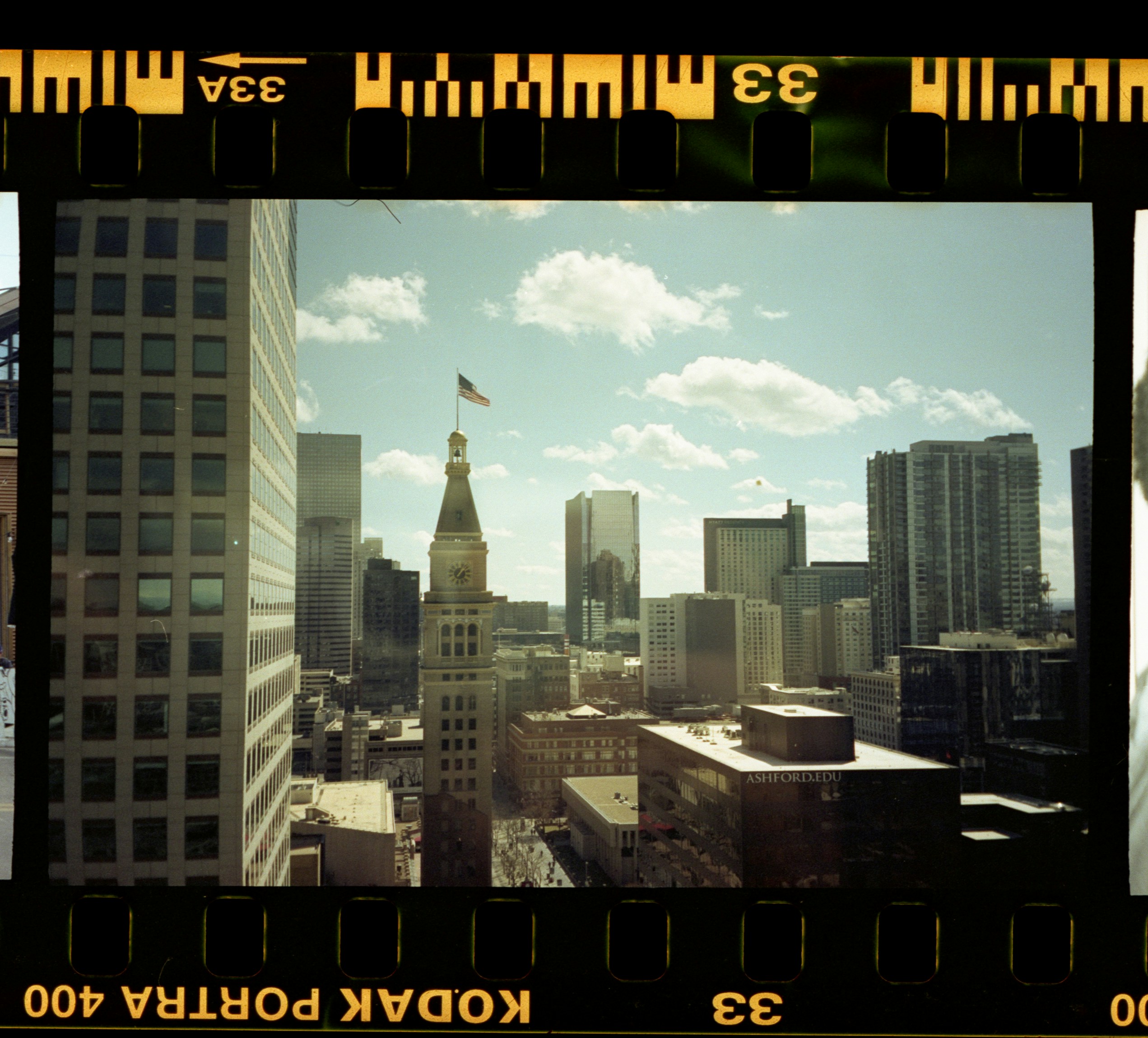Cinematic videos capture a lot of attention and emotion from viewers, this can lead to them engaging with your video content. Cinematic video editing is now an essential aspect that should be included in any video content.
In this article one of our video editors will tell you what you need to know about cinematic video editing.
Table of Content
- What is Cinematic Video Editing?
- Factors to Consider in Cinematic Video Editing
- Steps in Achieving Cinematic Video Editing
- Color Grading for Cinematic Effect
- Creating an Engaging Content Using Cinematic Edit
- FAQ
- What are some critical factors to consider in Cinematic Video Editing?
- Can you describe the steps involved in Cinematic Video Editing?
- What are some recommended software for achieving a cinematic effect in video editing?
- How important is color grading when aiming for a cinematic effect?
- How does Cinematic Video Editing impact the overall video content?
- How can I create engaging video content using Cinematic Edit?
- Post-Production Company for Advance Cinematic Editing
What is Cinematic Video Editing?
Cinematic video editing is an artistic approach used to transform everyday footage into a visually compelling narrative. This technique draws on the aesthetics of movies, offering engaging and dynamic views that can captivate the audience’s attention. Consequently, understanding how to make a cinematic video is a skill that has seen increasing demand, especially in the contemporary era of rapidly expanding digital platforms.
A cinematic video is not merely about capturing high-quality footage, it’s about enhancing the visual experience through strategic edits and refining techniques. Various elements such as camera angles, transitions, pacing, music, sound effects, color grading, and more, combine in a way that transports viewers into the world crafted by the content creator. These components build the essence of cinematic storytelling, significantly impacting the depth and emotive power of the narratives we watch on screen. Thus, giving life to a video, much like a magician breathes magic into a performance.
Factors to Consider in Cinematic Video Editing
In cinematic video editing, a number of critical factors demand careful attention. First and foremost is tempo or rhythm. The pacing of videos, shaped by scene length, shot transitions, and music, generates a specific mood that can either captivate or deter the viewer. Synchronizing rhythm and mood is a delicate art that distinguishes professionally edited videos from those that feel disjointed or amiss. Another pivotal factor is the quality of raw footage. The camera used and its settings, the director’s vision, the vibrancy of colors, and even an actor’s performance, all contribute to the raw material video editors have to work with.
Notable also is the aspect of continuity, an element that ensures the seamless flow of narrative in your videos. Discrepancies in costumes, props, setting, or actions from one shot to the next can create visual confusion, ultimately detracting from the overall viewing experience. Furthermore, understanding the intended platform and audience is absolutely essential. For instance, editing a video destined for Instagram, where short, eye-catching content is king, would require quite a different approach compared to editing a video for a documentary or feature film. Ultimately, understanding the nuances inherited from the camera and implementing them during the editing phase will amplify the visual narrative intended for the specific audience.
Steps in Achieving Cinematic Video Editing
The first significant phase in cinematic video editing involves the accurate selection and arrangement of clips. Here, the captured footage is trimmed and sequenced to construct a storyline that fits the director’s creative vision. It is important to ensure smooth transitions for each shot, striving to mimic the natural flow of human visual perception. It is at this stage that ‘color’ becomes a crucial element, as it plays a significant role in setting the mood, drawing attention to specific aspects, and enhancing the visual aesthetics of the video.
Once the sequence is established, the video editor will harness the power of advanced editing software. One of the most common tools in this scenario is ‘Adobe Premiere Pro’, which offers a plethora of features for creating stunning cinematic videos. From adding special effects and audio tuning to color grading and adjustments—Adobe Premiere Pro enhances the visual narrative of the video. Each feature is carefully manipulated to enhance the overall viewing experience, resulting in a production that transcends the ordinary viewing experience into a remarkable cinematic journey.
The second phase of cinematic video editing involves the use of advanced editing software. In this stage, editors utilize tools such as Adobe Premiere Pro to add depth and dimension to the video.
This software allows for special effects addition, which can significantly enhance the visual appeal of the footage.
Audio tuning is another feature offered by Adobe Premiere Pro that enables editors to manipulate soundtracks for a more immersive viewing experience.
Color grading and adjustments are also possible with this tool, allowing editors to set or alter the mood of scenes as per the director’s vision.
The third step in the cinematic video editing process is refining. At this point, all elements have been added but may need some fine-tuning or minor adjustments. It could be modifying color tones slightly or adjusting audio levels subtly—this stage focuses on enhancing every detail until they perfectly align with each other and contribute towards creating an engaging narrative.
The final phase in cinematic video editing encompasses rendering and exporting the project into a viewable format. Herein:
◦ Rendering refers to processing all edits into a single file—a time-consuming task depending upon the complexity of edits made throughout production.
Exporting implies converting your edited project into a format suitable for sharing or distribution—be it online platforms like YouTube or physical mediums like DVDs.
In conclusion, cinematic video editing involves multiple steps—from selection & arrangement of clips, harnessing advanced software features for enhancement, refining details to perfection—to finally rendering & exporting content in shareable formats—all aimed at crafting captivating visual narratives that evoke emotions and resonate with viewers.
Video Editing Software for Cinematic Effect
In the realm of digital storytelling, choosing the right editing software is the first step towards producing cinematic magic. The potency of these tools lies in their ability to transform raw footage into a visual narrative that encapsulates the creator’s intent. Whether it’s seamlessly stitching together a multi-angle shoot or masterfully syncing audio with video, professional-grade editing software enables content curators to bring their stories to life with unparalleled vigor and precision.
Investing in top-notch editing software is not just about employing advanced technical features; it’s also about empowering oneself with creative flexibility. It offers a wide variety of tools for special effects, animations, and transitions that can enhance the visual aesthetics of the footage at hand. Furthermore, such software typically comes with an array of color-grading options, enabling creators to truly fine-tune the look and feel of their content. From subtle changes in saturation to vast shifts in color schemes, these software-driven capabilities can dramatically alter both the mood and tone of any footage, paving a way to deliver an immersive cinematic experience.
Color Grading for Cinematic Effect
Color grading is an essential aspect of the post-production process that significantly contributes to the overall cinematic effect of a video. This is where the video’s color palette is manipulated to influence mood, atmosphere, and emotion in order to resonate better with the audience. For example, a warmer color palette could contribute to the warmth, joy, and light-hearted feeling of a summer romance movie, whereas a colder color palette could add to the gloomy and solemn atmosphere of a thriller.
However, color grading is a complex process that requires specific skills, an artistic eye, and the right tools. It’s not as simple as changing the saturation or brightness levels; it’s about understanding colors and how they interact. It involves adjusting the colors, highlights, shadows, and contrast to create the desired aesthetic and mood. Even tiny adjustments can have a significant impact on the video’s overall look. Therefore, it’s often beneficial for content creators to work with professional post-production teams, as they have the necessary expertise and advanced software to create the desired cinematic effect.
How Cinematic Video Editing Affects the Video Content
Cinematic video editing has a profound impact on the overall quality and reception of video content. A meticulously edited video strikes the perfect balance between visual aesthetics, audio quality, and seamless storytelling, thereby significantly enhancing viewer engagement. Editing essentially adds a heart to a video, animating it in a way that reels in viewers’ attention. By utilizing professional techniques such as strategic scene cuts, clever transitions, synchronous audio, and impactful visual effects, cinematic video editing shapes the narrative, lending an air of finesse that sets it head and shoulders above average content.
The relevance of cinematic video editing in content creation resonates particularly well when considering YouTube thumbnails. Social Channel Studios, for instance, understand the indispensability of compelling imagery, decipherable text, and appealing visuals. Thumbnails are essentially a sneak peek into the content, and about-to-be viewers are likely to be allured into clicking when thumbnails are visually engaging. They play a small yet highly significant role in enhancing the Click-Through Rate (CTR), thereby driving up the overall performance of the video. In essence, while cinematic video editing ensures the creation of splendid videos, the contribution of well-crafted thumbnails – a microcosm of the video editing process – cannot be overlooked.
Creating an Engaging Content Using Cinematic Edit
Engaging the viewer is at the heart of every meticulously edited video content. In the intricacies of cinematic editing, each detail contributes to crafting compelling imagery. The brilliantly bold visuals, and the crisp clear text, are all orchestrated to captivate the viewer’s attention right from the thumbnail. The minutiae of these elements are what drives the all-important Click-Through Rate (CTR). Having your video perform at its peak starts even before the play button is clicked. It’s about creating an enticement, a visual cue so intriguing, the audience cannot resist the urge to delve deeper. This is optimization at its finest, driven by the eye of a professional video editor.
Hiring a professional video editing studio like Social Channel Studios, though only representing one of the numerous paths to success, brings a wealth of expertise, efficiency, and quality to the creative process. In a sense, the content creator becomes the orchestra conductor, leveraging the abilities of experienced professionals to achieve well-defined content goals. The aim here is not just to create engaging video content, but also to craft a sustainable creative process that respects the creator’s well-being. Professionals understand that not every solution must be a revolution. Sometimes, crafting engaging content is about refining what’s there, polishing it to a shine that reflects the creator’s unique voice, while still maintaining a viewer-friendly, easy-to-understand format. Appropriate use of bold text for highlighting keywords, tables, and lists for neat presentation, and above all, good-natured humor and personal anecdotes keep the content personable and relatable. It’s an art in balance where engaging storytelling meets high-quality cinematic video editing.
Don’t forget to check out this video about how to apply correct cinematic effects on specific scenes and video shots.
FAQ
What are some critical factors to consider in Cinematic Video Editing?
Some important factors to consider in Cinematic Video Editing include the quality of the raw footage, the narrative flow of the video, the use of sound and music, and the application of color grading to give it a cinematic look.
Can you describe the steps involved in Cinematic Video Editing?
Cinematic Video Editing typically involves initial cuts and sequencing, adding effects and transitions, sound mixing, color grading, and finally, fine-tuning the edits for a polished finish.
What are some recommended software for achieving a cinematic effect in video editing?
Adobe Premiere Pro, Final Cut Pro, and DaVinci Resolve are a few highly recommended software for achieving a cinematic effect in video editing. They offer advanced features for color grading, sound design, and special effects.
How important is color grading when aiming for a cinematic effect?
Color grading is extremely important in achieving a cinematic effect. It helps in setting the mood and tone of the scene, and can greatly influence the overall visual aesthetic of the video.
How does Cinematic Video Editing impact the overall video content?
Cinematic Video Editing can significantly enhance the overall video content by improving its visual appeal, ensuring smooth narrative flow, and creating a more immersive and engaging viewing experience.
How can I create engaging video content using Cinematic Edit?
Creating engaging video content using Cinematic Edit involves careful planning and execution of the video storyboard, meticulous editing, effective use of sound and music, and most importantly, the strategic use of color grading and lighting techniques.
Post-Production Company for Advance Cinematic Editing


A collaborative venture with a reputed post-production company not only brings technical expertise to the table but also a range of compelling factors that can accelerate the success rate of video content. The expert teams at these establishments understand the significance of view-grabbing thumbnails for platforms like YouTube, underlining the need for striking imagery, concise text, and intriguing visuals. By skillfully designing such elements, they significantly increase the likelihood of a viewer clicking on the video, thereby enhancing overall content performance and reaching wider audiences.
Choosing to employ a proficient video editing service is a strategic move that content creators often make to capitalize on the experts’ efficiency and quality of work. Leveraging the professionals’ knowledge opens up more opportunities for content creators, giving them ample space to focus on their well-being and freedom to create more engaging content. This approach is not about promoting video editing services but shedding light on the advantages they offer. The aim is to provide an informative piece that assists content creators in realizing their content goals more effectively. To ensure easy readability and comprehension, this article will use bolded words to emphasize important points, incorporate lists and tables for better clarity, and even include a touch of amiable humor and personal anecdotes for a relatable read.
What is meant by Cinematic Video Editing?
Cinematic Video Editing refers to the process of editing video content in a manner that gives it a high-quality, polished look similar to what you would see in a movie theater. It involves various techniques including color grading, sound mixing, and more to create a visually compelling narrative.
If you are interested in hiring us or learning more about our services, please contact us today or book a free consult with one of our specialists. We look forward to working with you!


